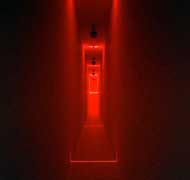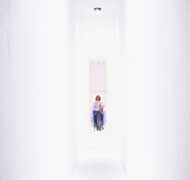“日本艺术家,Ryoji Ikeda,光谱 II” -- 在美国
发起人:嘿鬼妹 回复数:0
浏览数:2797
最后更新:2006/10/16 16:13:29 by
Photo: Robin Reynders (L)
Ryoji Ikeda,SPECTRA II
日本艺术家,Ryoji Ikeda,光谱 2
“感觉: 体现试验,科技和当代艺术 - 第一级”, MIT, Massachussets, 美国
10月12日至12月31日
装置内容为声音和建筑设计的交叉。关于光,声音,音调而它们如何显示和成为事实。这个装置像一个窄的走廊,观众只能一个一个走过去 。里面,红外线把这个空间分开几个部分。喇叭和灯在天花板里。光和声音同时工作,而一直变走廊的感觉。
Ryoji Ikeda, SPECTRA II
12 Oct – 31 Dec 06 | Sensorium: Embodied Experience, Technology and Contemporary Art, Part I | MIT List Visual Arts Center, Massachusetts, US
The installation relies on the intersection of sound and architecture and continues Ikeda’s interest in phenomena – be they light‚ tone or sound – and how they materialise and manifest themselves in the world. The piece is built as a narrow‚ ceiling–covered corridor‚ allowing only one visitor to enter at a time. In the corridor space‚ red laser lights mark out the architectural construction of the otherwise darkened space and divide it into sections. Along the length of the space, speakers and strobe lights are mounted in the ceiling. The flashing strobe lights and high frequency sounds are synchronised and continuously change the experience of the space.
Aiming at purity and simplicity in the sound, Ikeda deploys high frequency sine waves, only to subject them to his exploration of how pure tone and sound are distorted by the resonance and reflective qualities of a given architectural setting and the presence and movement of the public. Visitors can hardly recognise the dimensions of the space‚ which is almost invisible due to its intense darkness/brightness and inaudible due to its ultra–frequencies. However‚ as they pass through the corridor‚ subtle oscillation patterns occur around their ears‚ caused by their own movements interfering with the sounds. The sound itself may be subtle and minimal‚ but the experience of the sound in the installation is active and dynamic. It is only through the public’s physical engagement in the sound space that the real character of the work can be perceived.
"The contribution of Japanese artist Ryoji Ikeda is sensational. Ikeda‚ who also worked with famous architect Toyo Ito, makes sound tangible and sharpens the ears. Once outside, the sound on the street sounds like never before." – Volkskrant‚ Netherlands.
Produced by Forma

Ryoji Ikeda,SPECTRA II
日本艺术家,Ryoji Ikeda,光谱 2
“感觉: 体现试验,科技和当代艺术 - 第一级”, MIT, Massachussets, 美国
10月12日至12月31日
装置内容为声音和建筑设计的交叉。关于光,声音,音调而它们如何显示和成为事实。这个装置像一个窄的走廊,观众只能一个一个走过去 。里面,红外线把这个空间分开几个部分。喇叭和灯在天花板里。光和声音同时工作,而一直变走廊的感觉。
Ryoji Ikeda, SPECTRA II
12 Oct – 31 Dec 06 | Sensorium: Embodied Experience, Technology and Contemporary Art, Part I | MIT List Visual Arts Center, Massachusetts, US
The installation relies on the intersection of sound and architecture and continues Ikeda’s interest in phenomena – be they light‚ tone or sound – and how they materialise and manifest themselves in the world. The piece is built as a narrow‚ ceiling–covered corridor‚ allowing only one visitor to enter at a time. In the corridor space‚ red laser lights mark out the architectural construction of the otherwise darkened space and divide it into sections. Along the length of the space, speakers and strobe lights are mounted in the ceiling. The flashing strobe lights and high frequency sounds are synchronised and continuously change the experience of the space.
Aiming at purity and simplicity in the sound, Ikeda deploys high frequency sine waves, only to subject them to his exploration of how pure tone and sound are distorted by the resonance and reflective qualities of a given architectural setting and the presence and movement of the public. Visitors can hardly recognise the dimensions of the space‚ which is almost invisible due to its intense darkness/brightness and inaudible due to its ultra–frequencies. However‚ as they pass through the corridor‚ subtle oscillation patterns occur around their ears‚ caused by their own movements interfering with the sounds. The sound itself may be subtle and minimal‚ but the experience of the sound in the installation is active and dynamic. It is only through the public’s physical engagement in the sound space that the real character of the work can be perceived.
"The contribution of Japanese artist Ryoji Ikeda is sensational. Ikeda‚ who also worked with famous architect Toyo Ito, makes sound tangible and sharpens the ears. Once outside, the sound on the street sounds like never before." – Volkskrant‚ Netherlands.
Produced by Forma

